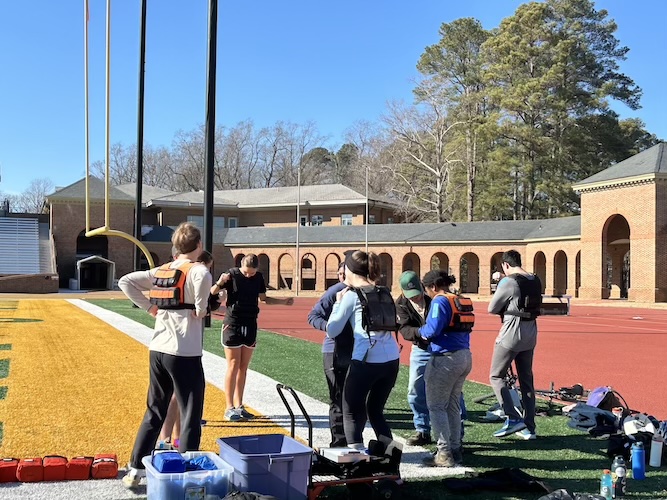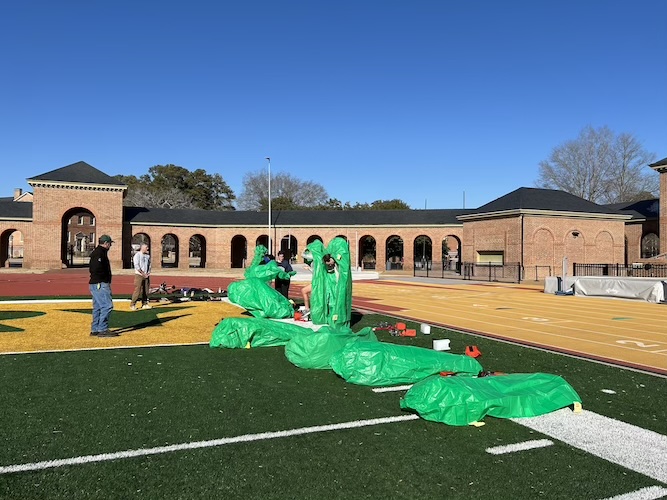Fighting fire with fire
Students learn the importance of prescribed burning in land management internship
February 3, 2025
By
Annie Powell M.A. ’18, Ph.D. ’24
Editor's note: A related story appears in the spring issue of the W&M Alumni Magazine.
While wildfires burned on the West Coast, nine William & Mary students gathered at Zable Stadium on a recent Saturday afternoon to practice fire management techniques. The students are training to acquire Wildland Firefighter Type 2 certification by taking online training, passing a fitness test and completing at least 40 hours of training and volunteering on burn crews.
These students are part of a land management and prescribed fire internship program led by Associate Professor of Biology Harmony Dalgleish — a program that is crucial to prepare for the types of environmental changes that scientists anticipate in the coming years. The need for people with fire management skills is only expected to increase, she says.

The recent Los Angeles wildfires — as well as a current outbreak in North Carolina — show the devastating consequences of uncontrolled burning. Beginning Jan. 7, fires raged across Los Angeles, especially the Palisades and Eaton areas, until rainfall on Jan. 27 significantly curtailed the fires’ progress. According to the California Department of Forestry & Fire Protection, the wildfires burned over 57,500 acres, destroyed more than 16,200 structures and killed an estimated 28 people. In western North Carolina, evacuations were ordered this week in a rural area still recovering from Hurricane Helene.
“Uncontrolled fires cause loss of property and loss of life, as we’re seeing in places like California right now,” says Dalgleish, who also teaches a fire ecology class. “If we do not change how we manage our ecosystems, then we’ll have more fire and will need more people to know how to manage it.”
The internship training focuses on prescribed fires — deliberately planned and carefully supervised by fire management officials — that can mitigate losses to human communities while also benefiting local ecosystems.
Prescribed fires improve local ecosystems by encouraging the growth of native species. The longleaf pine tree, for example, is a species that evolved with fire and requires regular burnings to maintain its health by removing invasive brush competition. Native to the Southeastern region of the U.S., the longleaf pine’s range had collapsed from about 1 million acres in Virginia before 17th-century European settlement to only 200 individual trees by the 1990s. With proper ecological management, including regular burnings, the longleaf pine range has been brought back to about 8,000 acres in Southeastern Virginia.
Olivia Cunningham ’25, a biology and environmental science major, was drawn to the internship program because she wanted an opportunity to help maintain ecosystems and habitats.
“Burning seems like a really destructive thing, but it’s necessary to maintain habitats that would otherwise not exist,” she says. Currently applying to graduate programs in ecology, Cunningham envisions herself using the fire management skills she is learning in her ecology career.
Prescribed fires also mitigate the risks that uncontrolled wildfires pose to human communities and firefighters.
“It’s much more challenging to fight a wildfire than conduct a prescribed burn,” says Bobby Clontz ’89, statewide fire manager and longleaf pine specialist at The Nature Conservancy, who is helping with Dalgleish’s internship program at W&M. “For a prescribed burn, planning and preparation is completed ahead of time. The firelines have been prepared in advance, and we’ve notified close neighbors, fire departments and, when required, received permits from regulatory agencies. Importantly, we have chosen the desired weather conditions, and we don’t burn until the suitable weather conditions are forecasted.”
That careful planning stands in stark contrast to the rapidity of a wildfire response.
“In a wildfire, we don’t have the advantage of preparation. We are concurrently working to extinguish a wildfire while assessing weather, rate of spread, whether we have enough firefighters and engines, while also determining the risks to neighbors and traffic safety,” Clontz says.

Rather than having the fire dictate its path and intensity, prescribed burning allows firefighters to determine those parameters.
Societies have used prescribed fires to manage and shape their surroundings into livable, healthy environments for millennia. Long before Europeans arrived in North America, Native Americans frequently practiced prescribed burning. Students in Dalgleish’s fire ecology class also study how Native American tribes are using fire today as a tool for social as well as ecological rejuvenation — a practice called cultural burning.
Dalgleish says that many people who push back against prescribed burning worry about the fires getting out of control (a rare occurrence) and are unaware of the beneficial environmental impacts.
Steven Hubner, a retired forester from the U.S. Fish & Wildlife Service who serves as the expert supervisor for the internship, says that “people drive by the public road and see us doing a prescribed burn and call the fire department because they think there's a wildfire.” Community concerns about prescribed burning also stem from a cultural history in the United States that emphasizes fire danger: Don’t play with matches, don’t play with fire.
There is a real need for trained wildland firefighters with hands-on experience, according to Hubner.
“If applications from students like these come in, and they already have fire training and they’ve already been out on some burns, those resumes go straight to the top,” he says.
Dalgleish hopes that students emerge from the internship with both practical, employable skills and a broader understanding that humans are not outside of the ecosystem but are critical to its maintenance.
"We have a role to play,” Dalgleish says, “which is bringing fire to these landscapes, these ecosystems that evolved with it and need it.”